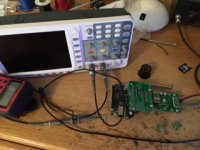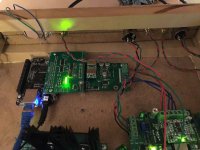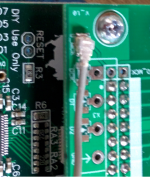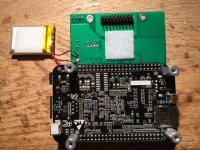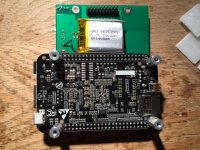I have one on my bench right at this very moment. 🙂 I am just finishing setting it up and I will post my progress as I go. I have finished testing the "Cronus" itself and it is working even better than expected. 🙂
Rhea boards also tested - go!
Just getting the the Hermes-BBB itself right now. Taking it slow and cautious (don't want to damage anything).
I already tested my battery backup/shutdown and it seems to work exactly as it should. I see only a few micro-amps of current draw on the battery after power down. I will keep testing this - but it seems to be a fine solution. Of course one could also use this power cape which is excellent:
BeagleBone Power Cape - AndiceLabs
Here is a pic of how it looks on my bench right now.
Cheers!
Russ
Rhea boards also tested - go!
Just getting the the Hermes-BBB itself right now. Taking it slow and cautious (don't want to damage anything).
I already tested my battery backup/shutdown and it seems to work exactly as it should. I see only a few micro-amps of current draw on the battery after power down. I will keep testing this - but it seems to be a fine solution. Of course one could also use this power cape which is excellent:
BeagleBone Power Cape - AndiceLabs
Here is a pic of how it looks on my bench right now.
Cheers!
Russ
Attachments
Success!
I am very glad to report I have it up and running. I am playing sample rates up to 384Khz 32bit as well as DSD-64 and DSD-128.
More details to follow.
I am very glad to report I have it up and running. I am playing sample rates up to 384Khz 32bit as well as DSD-64 and DSD-128.
More details to follow.
During the testing phase, for those of us who will not be using synchronous clocking with the DAC, can you give us some indication of whether best results are with 22/24 or 45/49 clocks on the Cronos?
It depends on the max sample rate you want.
If you want up to 192Khz 22/24 should yield best results. For up to 384khz you will need 45/49 (to give the FFs the proper timing), and you can go double that if you like.
I have tested both. They both sound excellent to me. 🙂
Superb.
Here is a pic of the beta build in the trusty (not fancy) test rig.
Cheers!
Russ
If you want up to 192Khz 22/24 should yield best results. For up to 384khz you will need 45/49 (to give the FFs the proper timing), and you can go double that if you like.
I have tested both. They both sound excellent to me. 🙂
Superb.
Here is a pic of the beta build in the trusty (not fancy) test rig.
Cheers!
Russ
Attachments
Thanks. Your last photo prompts another question:
I had always thought I would use one of your Trident regulators to power the clocks, but I see you have gone to a certain amount of effort to provide an onboard power supply on the Cronos. Is this onboard solution as good as a Trident?
I had always thought I would use one of your Trident regulators to power the clocks, but I see you have gone to a certain amount of effort to provide an onboard power supply on the Cronos. Is this onboard solution as good as a Trident?
Yes indeed it is a superb solution for this situation - otherwise I would not have done it. 🙂
The problem with making the vreg external is that it would not have as direct control over the rail (longer sense loop) - also a series reg in this case helps this unit integrate better with a larger stack. Also - it's one less thing for builders to have to worry about.
My initial beta used various external supplies, and I just found it was better to do it this way. I used the superb ADM7151 - and I wouldn't change it.
I built three prototypes (vastly different each) and this is the one I finally feel reaches the mark. And the others were good. 🙂 This one is just amazing.
Cheers!
Russ
The problem with making the vreg external is that it would not have as direct control over the rail (longer sense loop) - also a series reg in this case helps this unit integrate better with a larger stack. Also - it's one less thing for builders to have to worry about.
My initial beta used various external supplies, and I just found it was better to do it this way. I used the superb ADM7151 - and I wouldn't change it.
I built three prototypes (vastly different each) and this is the one I finally feel reaches the mark. And the others were good. 🙂 This one is just amazing.
Cheers!
Russ
I have now tested both synchronous and asynch(100Mhz at DAC). 😎 Very happy.
No issues going to no bandwidth on the DPLL.
No issues going to no bandwidth on the DPLL.
Russ/Brian, is there any chance you could give us a ballpark figure as regards the prices?
+1
Russ/Brian, is there any chance you could give us a ballpark figure as regards the prices?
Now that we have final boards to play with, I will assess what parts I think need to be included in the kit (connectors, clocks, etc), and will work out some pricing for the modules.
I hope to have some ballpark numbers ready in the next couple days.
I hope you guys will be offer two options:
All parts (assembled and tested) and boards only (no parts).
Please confirm.
Regards,
bern
All parts (assembled and tested) and boards only (no parts).
Please confirm.
Regards,
bern
I hope to have some ballpark numbers ready in the next couple days.
Opinion: the projects enabled by this new-generation interface will carry us for years. I think you can plan on SIGNIFICANT product volume as future advancements transition from 'board design/tweaking' toward code writing.

Frank
Nice, cannot wait to get my hands on one of these 🙂.It depends on the max sample rate you want.
If you want up to 192Khz 22/24 should yield best results. For up to 384khz you will need 45/49 (to give the FFs the proper timing), and you can go double that if you like.
I have tested both. They both sound excellent to me. 🙂
Superb.
Here is a pic of the beta build in the trusty (not fancy) test rig.
Cheers!
Russ
BTW Does the Chronos supply MCLK to the DAC or only to the BBB?
BTW Does the Chronos supply MCLK to the DAC or only to the BBB?
Yes, at the end of the board next to the other outputs.
Attachments
Last edited:
Great, thanks!Yes, at the end of the board next to the other outputs.
Installing a battery is really simple.
For safety just make sure its the type with a built in protection circuit that prevents both over-charging/discharging and under-voltage. This way you can safely just install (carefully) and forget.
I just used ordinary self adhesive hook and loop material.
When using Miero's distribution - when main power is lost - shutdown is automatically initiated.
After power is restored it will start up again.
It is proving to be a simple effective solution. I also have a power cape - but I don't see any need to use it right now.
Cheers!
Russ
For safety just make sure its the type with a built in protection circuit that prevents both over-charging/discharging and under-voltage. This way you can safely just install (carefully) and forget.
I just used ordinary self adhesive hook and loop material.
When using Miero's distribution - when main power is lost - shutdown is automatically initiated.
After power is restored it will start up again.
It is proving to be a simple effective solution. I also have a power cape - but I don't see any need to use it right now.
Cheers!
Russ
Attachments
Last edited:
I lost track of the development along the way, speacially regarding the shutdown problems. could someone explain the power shutdown problems and the need for the battery and special code needs?
- Home
- More Vendors...
- Twisted Pear
- Building an open embedded audio applicance.
